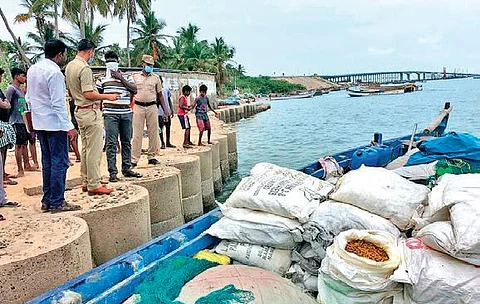

NAGAPATTINAM: It’s an integral part of the Asian cuisine. It is a wonder drug high in demand in Europe. It is a spice the Sri Lankan Navy is hellbent on keeping out of its territorial waters. It is an agricultural produce the Indian farmers cannot find a market for. It is your humble turmeric.
Little over a month after assuming office, Sri Lankan President Gotabaya Rajapaksa’s official Twitter handle put out a post (December 21, 2019) informing the people about the passage of a slew of Acts. The 697 likes and 62 re-tweets the post garnered was symbolic of the social media users’ proclivity to skim the surface, for a cursory reading of the legislation would have made them abreast of their wide-ranging ramifications. The Act-II of what happened in Colombo was to play out in the coastal Tamil Nadu.
The pain of the Easter Sunday Attacks was still fresh when Rajapaksa staked claim to the presidential seat in 2019. He had harped on national security, nationalistic temperament, and economic development throughout the hustings. The Acts mentioned in his December 21 tweet were in line with his promises. One of the legislation to pass muster was a blanket ban on the import of spices, including turmeric.
The purpose behind the ban was to strengthen the Sri Lankan economy by augmenting domestic production, all the while helping farmers come out of the debt trap. However, for a country producing only 2,000 tonnes turmeric a year against a national demand of 7,000 tonnes, the shortfall was huge. With the administration showing no let up, the task of plugging the demand-supply gap fell on the unofficial machinery, which knew where to look for the spice.
Turmeric is being smuggled mainly via four routes — from Velankanni, Kodiyakarai and Vedaranyam to Point Pedro in Jaffna district; from Sethubavarchatram in Thanjavur district to Jaffna; Trespuram in Thoothukudi to Mannar, Kilinochi and Puttalam in Sri Lanka and from Kannirajapuram, Vedhalai and Dhanushkodi in Ramanathapuram to Mannar, Kilinochi and Puttalam.
The town of Vedaranyam, notorious for smuggling ganja to Sri Lanka, is home to many cartels. “Dodging the eyes of the coastal security personnel, Sri Lankan vessels reach the shores of Vedaranyam to procure Cannabis from agents. The same modus operandi is being followed for smuggling turmeric now,” they said.
When asked how the Sri Lankan vessels manage to reach Indian shores without being noticed, a Marine police official said the vessels of Indian Coast Guard have to patrol a larger Indian coastline while the island nation has sufficient vessels to monitor the smaller Lankan coastlines. “The Lankan boats reach Indian shores when Indian boats return to the sea,” he said.
The Coastal Security Group has sounded an alert in Thanjavur, Tiruvarur and Pudukkottai districts that share borders with the coastline near Palk Bay. The turmeric rhizomes are brought to the coastal districts in small consignments from various districts, including Erode. They are allegedly aggregated by the ganja cartels in places such as Vedaranyam and later, the hand over the rhizomes to the smugglers from Sri Lanka.
Sources said the coordination between fishermen in Nagapattinam and Coastal Security Group is limited as the fishers believe that the personnel are not offering enough safety for them in mid-sea. “Our men do spot Sri Lankan vessels waiting for consignment near the shores, but they ignore them,” said Kaliappan (name changed) a fisherman from Kodiyakarai.
The Coastal Security Group officials said they are pinning hopes on the fishing harbour to be established at Arukatuthurai, as the place is near Kodiyakarai. “We have a unit stationed in Vedaranyam on behalf of Coastal Intelligence Service, and we have managed to stop several attempts of smuggling in the past two months. We are operating with limited personnel and are largely dependent on informants. We will be able to function better as a unit if we get more staff,” said an official from Coastal Intelligence Service.
According to the Sri Lankan online media The Morning, the price of a kg of turmeric before the import ban was 325 Sri Lankan Rupees (`126) with an import tax of 102 Sri Lankan Rupees (`41). The price has risen to 4,000 to 5,000 Sri Lankan Rupees (`1,600 to 2,000), the website said. An official in Ramanathapuram said that with the help of local fishermen in coastal districts, the spice is being smuggled from the State and is bartered for Sri Lankan gold.
“The local fishermen from the two countries meet at the International Maritime Boundary Line and exchange hundreds of kg of turmeric packed in gunny bags for gold,” he said. Another official said that until a few months ago, the black market agents could be tracked as the fishermen who exchange the goods in mid-sea used to communicate through mobile phones.
“When we strengthened the coastal security, the fishermen stopped carrying phones during the ‘trade’. Now they in their boats at the assigned location near the IMBL for days under the pretext of fishing until they meet their buyers. This arrangement is makes it difficult to track the smugglers,” he said.
(With inputs from Thanjavur, Thoothukudi, Ramanathapuram)